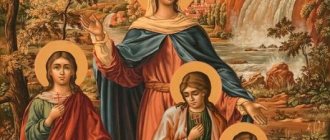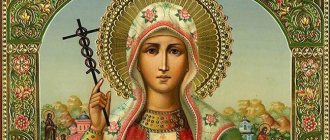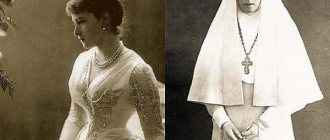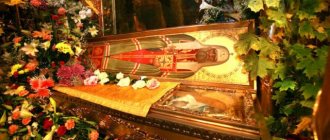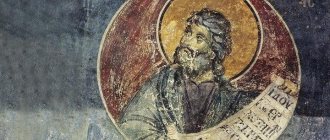What is known about the life of the holy Queen of Rome
In 284, Diocles was proclaimed Roman emperor, calling himself Diocletian. The death of Emperor Cara and his son Numerian caused the concentration of power in the hands of former military leaders. Diocletian divided the empire into 4 provinces, leaving one under his control, and appointed Caesars in 3. To strengthen the alliance, marriage alliances were concluded with the daughters of the Caesars and the emperor.
Diocletian was an opponent of Christians, because he believed that this creed contributed to the collapse of the empire. He set the goal of reviving paganism in order to legitimize his power. By his order, Christian churches began to be destroyed in all provinces. Followers of Christ's teachings were forced to publicly get rid of books and make sacrifices in a pagan temple.
On the territory of the empire there was a law according to which Christians could not hold public office and were not subject to protection in court. Particularly cruel persecutions (torture, executions) were used in the lands controlled by Diocletian.
Unjustified cruelty caused internal protest not only among believers in Christ, but also among those raised in the pagan faith. This happened to the emperor’s favorite military leader George, his wife Alexandra and daughter Valeria.
George was born in the city of Beirut and was raised in the Christian faith. The spread of the new religion in the 2nd century AD was supported by the Roman rulers. The number of adherents of the faith grew. George became a military man. The brave, intelligent soldier was noticed by his commanders and received a promotion.
George distinguished himself in wars of conquest and suppression of uprisings on the borders of the empire. By order of Diocletian, the army became a tool for suppressing dissent. The detachments entered villages where Christians lived. If they refused to make a sacrifice before the pagan gods, people were subjected to torture and execution.
George could not clearly violate the order, but contributed to the salvation of his fellow believers. Traitors were found who denounced George to Diocletian. The commander was recalled to Nicomedia (the capital of the eastern Roman province) and interrogated. George did not deny that he believed in Christ and would not renounce the teaching. He made an angry appeal to the ruler, calling on him to stop the persecution of Christians.
The angry ruler ordered to subject him to severe torture:
- The saint was imprisoned, his legs and arms were chained, a heavy stone was placed on his chest, which pressed him to the ground and did not allow him to breathe. The Lord gave him strength to withstand the test.
- After being beaten with ox sinews, the bloody martyr was thrown into a ditch with quicklime so that it would corrode his flesh to the bone. Prayerful appeals to God again saved George from suffering.
Queen Alexandra grew up in a pagan family. Diocletian's desire to revive the worship of pagan gods did not outrage her. Rumors about the torture of one of their military leaders for their faith in Christ spread throughout Nicomedia. Alexandra was amazed by George’s courage, the strength of his faith and the support of the Lord. She witnessed how the martyr was pulled out unharmed from the quicklime.
Diocletian, seeing how impressed his wife was by the Christian’s miraculous salvation, ordered her to go to the palace. George's torment lasted 8 days. Queen Alexandra could not stand the imprisonment, came to the place of torture of the great martyr, fell at his feet and announced that she accepted the faith of Christ, rejecting the pagan gods.
The angry emperor ordered both their heads to be cut off. The execution was to take place outside Nicomedia. On the way, Alexandra felt tired and asked the guards for a short break. She sat down by a rock and died. The guards left the body of the Nicomedia Empress lying on the road and went further to the place of execution. The death of the queen on April 21, 303 is recorded in the act of martyrdom of St. George.
The Lord did not allow the new convert to die. Death was imaginary. Alexandra, together with her daughter Valeria, preached the covenants of God in Syria for another 10 years. In 313 they returned to Nicomedia, hoping for a change in attitude towards Christians on the part of the new emperor Licinius. The treacherous ruler ordered the heads of the mother and daughter to be cut off and the remains thrown into the sea.
Serving your people and Fatherland
Historical science knows the Holy Blessed Prince Alexander, first of all, as a successful military leader who did not lose a single battle. He is celebrated as a talented statesman who was able to lay the foundation for the formation of Russian statehood.
Prince Alexander was born in 1221 in the town of Pereslavl-Zalessky. He began to reign in Novgorod from the age of seven.
He will have difficult relationships with the Novgorod boyars throughout his life. However, this city, like the northern principalities of Rus', owe their safety to him during the period of the cruelties of the Mongol-Tatar invasion.
The Grand Duke reigned for 35 years. These were difficult years for our lands. Most of Rus' was burned out by the Mongol conquerors. It was necessary to negotiate peace with them in order to preserve what was left. The western and northern borders were captured by the Crusader orders and the Swedes. The young prince, with a small squad, defeated the Swedes’ army on a tributary of the Neva, for which the people called him “Nevsky”. Then on Lake Peipsi he also defeated the crusaders of the Livonian Order. He pushed the knights of the Teutonic Order from the borders of his principality. He conducted flexible negotiations with Norway and the Prince of Lithuania, and concluded trade agreements with German cities.
At that time, the spiritual expansion of Catholicism was underway. The Pope promised the appanage princes help and protection from the Golden Horde in exchange for accepting the protectorate. However, Prince Alexander refused such crafty “support”.
Rus' was weak. At this time, all its spiritual, territorial and cultural principles could collapse. During the period of his reign, showing wisdom, flexibility, and prudence, the noble prince Alexander took care of preserving the surviving principalities, rebuilding burned cities, and preserving his people. It was in these labors that the prince remained until the time of his death. Having accepted the vows of monasticism and the schema in 1263, Alexander Yaroslavovich went to the Lord with prayer for his land and his people.
Veneration of the Great Martyr
Memorial Day of Alexandra of Rome - May 6 (April 23, old style). The day of death (April 21) of the queen was mentioned in the Divine Service Charter of the 10th century. In the Minology of the Byzantine Emperor Basil II (a collection of the most important Christian events with illustrations) there is a miniature depicting the execution of the Great Martyr. George and the death of Alexandra of Rome and a brief description of her life.
Theophan the Inscribed, a Byzantine monk canonized by the Orthodox Church, was the author of a canon in honor of Alexandra of Nicomedia. It was not included in the practice of Orthodox worship. The troparion about the Roman martyr is read during the service in honor of St. George.
The Roman queen was recognized as the heavenly patron of the Russian empresses, who accepted the name Alexander at baptism into Orthodoxy:
- Alexandra Feodorovna, wife of Nicholas I. Years of life – 1798-1860. Before her marriage, Princess Friederike Louise Charlotte Wilhelmina of Prussia.
- Alexandra Fedorovna, wife of Nicholas II. Years of life: 1872-1918. German Princess of Hesse-Darmstadt.
In Armenia, on the territory of the Russian military base “Alexandropol” (named after Empress Alexandra Feodorovna), construction of a temple began in 1837. In 1842, it was consecrated in honor of the heavenly patroness - the holy martyr Alexandra. In 1918, the church was burned by Turkish soldiers. In 2008-2009, the temple was restored and consecrated.
In 1840, during the restoration of the Church of Joasaph in Izmailovo, one of the Thrones was reconsecrated in honor of Alexandra of Rome. In 1936 the temple was destroyed.
Piety and spiritual achievement
Power is a difficult test for any person. If he is gifted with the talents of a commander, strategist, politician and diplomat... Then power is capable of sweeping away all spiritual priorities and crushing the sprouts of spiritual purity.
The main ascetic feat of a ruler consists of preserving philanthropy, preserving the skill of looking at the sky with humility. History shows that even in our Orthodox land such statesmen are very rare.
The holy noble prince Alexander won the main battle that faces any Christian - the battle for his soul. Behind the actions of a warrior and a politician, a sensitive eye sees valuable evangelical virtues.
With humility and trust in God, the holy prince suppressed his pride when he went to the Horde. In order to ask for peace again and again for their lands. He was eager to defend the faith of his fathers when he said before the battle with the Swedes: “ God is not in power, but in truth .”
The noble prince Alexander became like the biblical Joseph when again and again he forgave his brothers in Christ, the Novgorodians, who arrogantly expelled him several times. From year to year, he carefully decorated and donated temples, granted them land, and gave them utensils and books. Thus strengthening the Orthodox faith.
Monasticism
At critical moments, the foundations of the inner life of the soul manifest themselves most clearly. Some people panic and give up, some begin to blame others for everything, some go crazy.
A strong spirit takes the blows of fate steadfastly. The believer seeks support in his trust in God. It is in Christian piety that one should look for the origins of the courage and wisdom of the blessed Prince Alexander.
The last days of a person’s life show the main goals of life that he set for himself. Constant rewriting of the will, vanity and despondency are signs that the soul has become attached to the riches of this world. An empty look of despair is a sign of disbelief.
The schema and the adoption of monasticism are evidence of the priority of Christian spirituality in life. Having lost his bodily strength, the holy noble prince Alexander enters the field of deep prayer before God for his people. Judging by the events of subsequent centuries, he was not defeated on this path either.
Iconography
Icon painters depict Saint Alexandra of Rome separately, in a plot with the Great Martyr George and the angel, Emperor Diocletian. On the icon the martyr is depicted in royal attire, with a cross in her right hand. The left hand is raised in a blessing gesture.
The icon painters' reference book "Erminia" contains a description of Alexandra during the execution of the Great Martyr George: the dead queen sits on a stone, an angel accepts her soul. In the confession story, the Roman emperor threatens Alexandra standing before him.
Veneration and canonization of Alexander Nevsky
Veneration of the prince’s burial place begins immediately after his death. Miraculous healings occur at the tomb of Alexander Nevsky. One can feel the invisible participation of the saint in the formation of the statehood of Rus'.
It is no coincidence that his relics were discovered in 1380, precisely in the year of the Battle of Kulikovo. The saint himself appeared before many participants in this battle. Strengthening them, as once the holy passion-bearers Boris and Gleb strengthened his army before the battle with the Swedish army.
In 1574, the church canonization of the blessed Prince Alexander took place. Until 1723, the holy relics of the prince were in the Vladimirovskaya Nativity Monastery. When Peter the Great handed over St. Petersburg to the heavenly intercession of the blessed prince, his relics were also transferred to the capital.
Meaning
The ideas of Alexander Nevsky formed the basis of the policy of Russian statehood for many centuries. Negotiating with the East, earning the respect of the West with one’s military prowess – these are the vectors that are easily visible even in the external relations of modern Russia with other powers.
Through the efforts of the noble prince, the Orthodox faith was preserved in our lands as the basis of Russian statehood . Like a centuries-old way to save the soul. Finally, with his piety, he set a high spiritual bar for any leader of the people.
